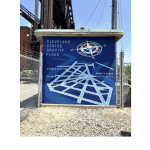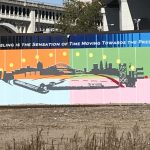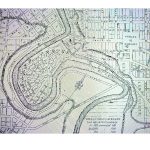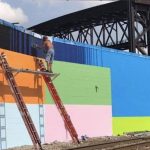Project Detail Pages: 1. 2. 3. 4. 5. 6. 7.
Working with what is already there
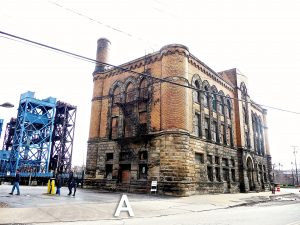
Working with what is already there – these points of change will re-establish the authentic “Cleveland Centre” following the metro parks lead, re-engaging the public as follows:
- Illuminate the three Cleveland Centre Murals
- Rename Columbus Peninsula to be Cleveland Centre
- Road network identification; street marking with reflective paint.
- Placement of the Wayside Marker on Gravity Place officially identifying the history of the City Centre layout of 1833 on Columbus Road.
- Hub definition; Compass Mural at Gravity Place.
- Fall Street Extension connecting to Columbus Street through the parking lot area where recreation occupies the west end of the Peninsula.
- Illumination of road network.
- British Street pathway reintroduced into the road network.
- French and Fall Street – Centre Piece Mural identifying the east west divide in the Peninsula Center.
- St Mary’s Church mural, depiction of the Phi Ratio orienting the church site in the Cleveland Centre Plan.
- Ohio Erie Canal Turn Basin Park – Fountain Proposal – focal point for Fall Street and Canal Basin Channel restoration.
- Sherwin Williams B&O Depot “Castle” overlooking the “city centre village” renovation proposal* – creating a Cuyahoga Valley Museum Resource Center.
*Museum of the Cuyahoga Valley and Cafe – Integrating Landscape with the Federal Building including the scenic Canal Basin restoration providing a multi-nodal attraction under the Canal Street Bridge… Landscape integration; Pedestrian Pathway from parking lot along the Cuyahoga South River edge from Gravity Place to B&O Depot, including decommissioned Rail lift-bridge and Carter Street pilothouse redevelopment for pedestrian path access over the river to Scranton Peninsula.
“You can market your way back to relevance adapting programs which bring students… STEAM – Science, Technology, Engineering, Arts, Mathematics… it’s a win win for the arts and humanity, really!”
Project Detail Pages: 1. 2. 3. 4. 5. 6. 7.
Discovering The Cleveland Centre Concept
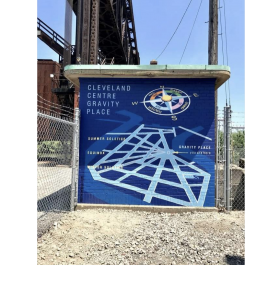
The Cleveland Centre Plan encompassed the Columbus Peninsula fostering the idea of circulation to develop a lateral route across the river valley. The circulation in the landscape puts an indelible stamp on our psyche.
After more than 189 years of gradual change we discover the comprehensive city centre landmark still emulates the enclosure of an observatory, tracking the movement of daylight in the sequence of seasonal change. Here Cleveland was given the shared nature of an understanding, orienting local productivity to social and natural laws with the cultures and economies of the world.
“An island of soul lifting land found in the clutter of over-industry.”

“We hold these truths to be self evident” ~ The Declaration of Independence
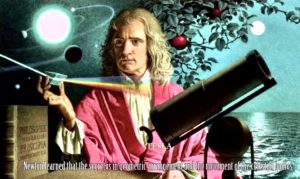
“Newton learned that the secret is in geometric arrangement and the movement of the celestial bodies”
The figure of Sir Isaac Newton looms large over the concept of a mechanical universe. In his journals he describes the world as clockwork; “An immaterial force guides the whole of creation, its presence manifesting through such phenomena as motion and gravity.” Cleveland Centre is a resurrection modeling Sir Isaac Newton’s truth, following life cycles that coincide with the Equinox and Solstice transitions and linking human order to the phenomenal world.
Rediscovering The Cleveland Centre Concept
“To unfold the beauty and happiness and mastery of life man shall be helped through incarnation”- Proverbs
From the Louisiana Purchase in 1803 an intensified American migration to the west was already well underway, making inroads where rivers and inland waterways allowed dependable internal transport. After the War of 1812 a more distinct character formed that included dramatic political innovations with the surge of western settlements. To strengthen bonds, the concept of centrality formed stable and legitimate federations, providing efficiency and effectiveness for individuals and minority groups to build larger communities.
In pre-electric America all people knew the relationship between matter and spirit was manifested in nature, traditionally represented in the “Tree of Life”, symbol of seasonal cycles growth and self-renewal.
“Man is a tree of the field” – Deuteronomy 20:19
Putting people in contact with their own divinity the “Tree of Life” etymology refers to time, infinitely bound through the genesis of soul and humanity. The “Tree of Life” is life itself, expressing a movement toward a source and a movement toward life in the Cleveland Centre Plan. Here Cleveland was given the shared nature of an understanding, orienting local productivity to social and natural laws with the cultures and economies of the world.

“To everything there is a season, there is a purpose and grace for all” Ecclesiastes 3:1-8
“An island of soul lifting land…”
Project Detail Pages: 1. 2. 3. 4. 5. 6. 7.
Project Detail Pages: 1. 2. 3. 4. 5. 6. 7.
The 1833 Archive Map
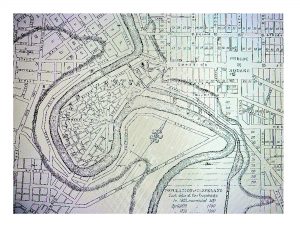
Looking at the Archive Map by Chief City Engineer, Ahaz Merchant, shows a street grid encompassing Columbus Peninsula and within this river edge, the Cleveland Centre blueprint emanates. Originating dynamically from its midsection, the center-point location named, ‘Gravity Place’ fixed its hub on the rising sun, establishing a still point in the movement of time. From this central relationship a sunburst of streets fan west toward the sunset on the horizon of Lake Erie. The City Centre emanates the enclosure of an observatory tracking the movement of daylight and the sequence of seasonal change.

Current Map of Cuyahoga National Park
In 1796 Moses Cleveland surveyed a Euclidian Grid imposing a New England town square in the Western Reserve frontier for real estate speculation. By 1833 the Cleveland village had 5,000 residents. As population spread out between East and West side settlements at the mouth of the Cuyahoga River, “Public Square” was not adequate to provide unity for the city, divided by growth and demanding a greater order.
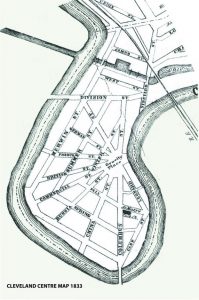 Dedicated with the Ohio Erie Canal, the Centre established Columbus Road as the N/S axis in the environment. Originating dynamically from its midsection, the centerpiece division named “Gravity Place” astronomically fixed its hub on the rising and setting sun. At this midpoint a sunburst pattern of streets fanned westward across the peninsula creating interior allotments intended for residential and commercial growth. Streets named for various migrating nationalities ~Russia, China, German, British, French~ bisected roads named for the seasons. A Symbol of unity, penetrating barriers of language, as kinship with nature and the man were linked.
Dedicated with the Ohio Erie Canal, the Centre established Columbus Road as the N/S axis in the environment. Originating dynamically from its midsection, the centerpiece division named “Gravity Place” astronomically fixed its hub on the rising and setting sun. At this midpoint a sunburst pattern of streets fanned westward across the peninsula creating interior allotments intended for residential and commercial growth. Streets named for various migrating nationalities ~Russia, China, German, British, French~ bisected roads named for the seasons. A Symbol of unity, penetrating barriers of language, as kinship with nature and the man were linked.
Ten years after Cleveland Centre and the Canal were established, Cleveland population zoomed to 20 thousand. Railroads, a cheaper source of transport moved in. Taking the path of least resistance, tracks followed the low-lying lakeshore and rivers edge routes. Cleveland Centre streets became active rail yards, erasing the west end of the peninsula, altering the road radius circulation. All land uses remained except for residential, driven away by industrial growth. For the next 180 years, without the critical circulation function the organizing principle of Cleveland Centre was forgotten.
Sine and Cosine Visualized:

In following life-cycles that coincide with human order, we discover global rotation is in relation to our greater reality. Situating everything, the boundary of self disappears, united to the harmonic forces of the earth. Here the face of the Cleveland Centre becomes an historic attraction connecting Cleveland and the Canalway Towpath Trail to the Cuyahoga Valley National Park – where outdoor exposure is a basic nutrient of life.
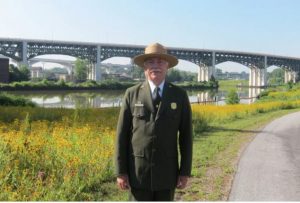 “For nature near home will create more respect, care, and political support for National Parks developing the conservation constituency in a newer generation that will need to protect their country’s historic sites, scenic wonders and sacred places…protecting their country’s historic sites…The National Parks are our holy places.”
“For nature near home will create more respect, care, and political support for National Parks developing the conservation constituency in a newer generation that will need to protect their country’s historic sites, scenic wonders and sacred places…protecting their country’s historic sites…The National Parks are our holy places.”
Johnathan Jarvis visiting the Cuyahoga River in Cleveland, Ohio
Project Detail Pages: 1. 2. 3. 4. 5. 6.7.
Project Detail Pages: 1. 2. 3. 4. 5. 6. 7.
Phi Ratio – Turning Point Sequence
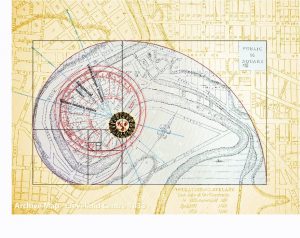
Surviving from the pre-electric age, the local to global perspective engineers undulating view. In terms of a real relationship, immediate presence plays an important role in our esthetic. Spatial alignments with astronomic coordinates engage our perception. Conceived as a whole, the Phi Ratio of Cleveland Centre is fundamental to the experience of physical reality. An alignment portal opening a genuine encounter to distance and time.
Here, the setting on the river is calculated using the Phi Ratio framing the Columbus Peninsula edge. Joining Cleveland’s North from Public Square, the ratio curvature follows the river escarpment spiraling South to the pivotal site of St. Mary’s Church, the first catholic church in the city. The centerpiece division named “Gravity Place” fixed the compass on the sun rise. From this axis a reciprocal orientation appears configuring Leonard Street, the road layout unlocks a Phi Ratio following the curvature of the river into the site of St. Mary’s Church.
This enables us to think in long arcs well beyond the quick-flash processes of our age; there is definitely an experiential effect – bringing one to a sense of “center” – being opened in this way.
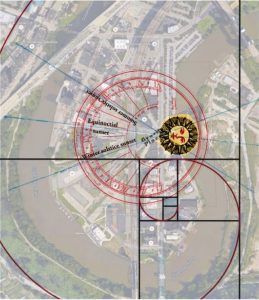
“To rediscover the past is to move forward. There is no development when we constantly destroy what we have built. The future is carved with the implements we created before it was. The past offers the different roads, all converging towards the present. Today’s present…it’s dangerous not to know – without past life memory we have no way of avoiding error” ~ Mark Tobey
Project Detail Pages: 1. 2. 3. 4. 5. 6. 7.
Project Detail Pages: 1. 2. 3. 4. 5. 6. 7.
Cracking The Code

One face turned toward the universal and another face turned towards the individual…
Rediscovering the legacy of our forebearers Cleveland Centre rises again. Just as the 1833 plan offered a calculus for Cleveland that developed into a cosmopolitan metropolis, Cleveland Centre illuminates how the city can awaken it’s core with an enduring vision. Its geocentric dimensions inspire the development of the Cleveland Centre Mural Project and the cosmic alignment of the community in contact with the environment.
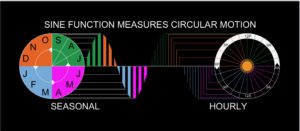
Relative to engineering sine function animates Cleveland Centre as a coordinate plane that calculates the earth rotation. Thus mapping degrees of sunlight and migrations of seasonal change turns us toward all the possibilities in ourselves, merging perception to the background of eternal existence.
“We can not stick to the moving finger of time on the surface of the sphere, but must descend to the still point of the turning world.” – T. S. Elliot
There is a narrative here: Cleveland Centre of 1833 is a “gift from one age – to another.” They are connected; one flows into the next. It’s profound and the genuine historic perspective becomes a main attraction unifying the river center to metro and national parks.

“Only by reaching a center of gravity in myself capable of reconciling my different aspects will I be able to keep a precise line without deviating… It is a real understanding of energies and their relation in ourselves with everything around us… A way toward consciousness through direct experience.” – Conge
Project Detail Pages: 1. 2. 3. 4. 5. 6. 7.
Project Detail Pages: 1. 2. 3. 4. 5. 6. 7.
The 3 Cleveland Centre Murals
The Centerpiece Mural …where the city divides on the Columbus Peninsula
Click Here for the Centre Piece Mural Story
The Compass Mural …Gravity Place, Columbus Road
Click Here for the Compass Mural Story
The St. Mary Church Mural …showing the progression of the Cleveland Center road layout determined from sacred geometry
Click Here for the St. Mary Church Mural Story
The underlying principles are genuine and not decorative contributing to the synchronicity of deeply shared values.
I would like to recognize and thank the individuals and organizations that helped to bring this public art project into reality – together we made it happen for the benefit of you! To gain more appreciation for our historic City Centre on the Cuyahoga River.
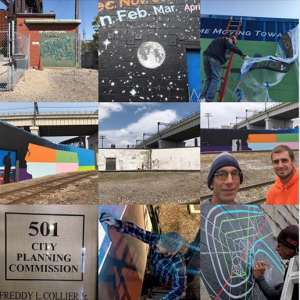

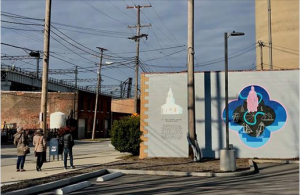
In no particular order of thanks and appreciation:
~ Councilman Kerry McCormack, Lilian Kuri, Jack Bialosky, Melinda Gigante are officials who supported the mural project. I am hopeful they will influence the future vision and planning developments of Columbus Peninsula incorporating the vision and concepts the murals help to identify.
Finding support from Day 1, I would like to recognize Clayton Koppes, Dean Shaffer & Skipp Cooper for writing/encouragement. Thank you Carl Jones who introduced me to Jim O’brien, CEO of the Observer~ providing a 2 page center spread, May 2017 Ohio City Observer. Steve Litt of the Plain Dealer produced 2 articles in May & June inspiring me to envision this public art undertaking and Robert Brown my mentor and friend.
Many people have contributed to the realization of this project ~ Special thank you, Jordan Satterfield~rendering, Dustin Haynes~painting, Maureen Pergola~County Archives, Tarra Petras~City Public Arts coordinator, Cheryl Ball~ Flats Industrial RR, Pat Gillespie, Brian Fabo, Kevin Golden, Tim Donovan/Kathey Cole~Canal way Partners, Rbt. Brown, Maureen Dee/Cleveland Catholic Charities, James Rosenberger, Spaces, Peter Sampson, Harriett Allen, Susan Sugar, Suzy Hecht Remer, Bob Zimmer, Rob Schoner, Mike Folczynski, Darryl Young… & many others thank you all for your contributions and support!
Project Detail Pages: 1. 2. 3. 4. 5. 6. 7.
Project Detail Pages: 1. 2. 3. 4. 5. 6. 7.
Illumination of Road Complex Proposal

“Today, Gravity Place is part of a riverfront zone on Columbus Road Peninsula in the Flats where aging industries are interspersed with attractions such as Merwin’s Wharf, the riverfront restaurant operated by Cleveland Metroparks, and recreational facilities operated by the Cleveland Rowing Foundation and the Foundry, a youth rowing program.
As the Plain Dealer’s architecture critic, I’ve been contacted through the years by Clevelanders who have wanted to float trial balloons for various redevelopment ideas… Reviving the radial street pattern in some form, possibly through rows of lights, as suggested by the rendering posted in the gallery that accompanies this column, is an idea worthy of exploration.
That’s because Gravity Place is a fascinating artifact of early 19th-century American town planning. It echoes the radial street pattern of downtown Detroit devised by Augustus Woodward and the multi-radius pattern created for Washington, D.C., by Pierre Charles L’Enfant.
We’ve got just a little bit of that mojo at Gravity Place, and it’s worth exploring how to bring it back…”
-Cleveland Plain Dealer, Steven Litt – May 1st, 2016
 Here is the link to the Cleveland Plain Dealer article
Here is the link to the Cleveland Plain Dealer article




